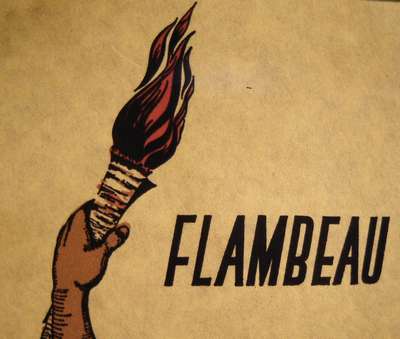
Rail service has been a part of it since the beginning,
with the work being done by a company locomotive.
There was switching of boxcars, flatcars, and coal hoppers at the main mill.
110 years ago, the tracks also ran a few miles downriver to the power dams .
Wood was hauled to the dams to make stone-ground pulp,
and wet lap pulp came back to the main mill to add to the supply for the paper machine.
The dam portion of the railroad was no longer needed after 1922 when the process was changed to chemical pulping.
I have about 3 dozen pictures of relics and old foundations of that era.
Also, in 1980, I had interviewed a retired employee who remembered how the dam portion of the railroad operated.
From that, I made maps and plans of the dams and buildings.
This web page is just some preliminary information and has been on the Internet since 2012.
Since then I have learned a lot more and now know that many pictures of the era are available from the Guy Waldo collection at the Price County Historical Society.
My own collection of stories and blueprints and pictures and maps is about 30 pages long as of February 2019.
|
It took many years to see a picture of the first paper mill steam locomotive that worked the paper mill, from 1895 to 1913. An internet search in 2012 brought out Shay with boiler serial #163, built 2-9-1887, sold new to Sherry & Wilard (Henry Sherry) of Sherry, WI, a Wood County lumber company, and that went to Flambeau Paper Co of Park Falls in 1895. I wonder if they would have attempted to run that slow engine up the old Wisconsin Central to get to Park Falls? Those Shays were good climbers, I wonder if they crawled it up a ramp and onto a flat car? John B came up with some history of that Shay, and says it was scrapped after locomotive No. 2 came to the mill, which was 1912.
And the Shay is NOT the 'Lima Shay which today supposedly rests at the bottom of Blockhouse Lake'. I digress, now its time to get back to the topic. |
|
There was a locomotive historian that helped save some history of locomotive No. 2, and that helped me a lot. I think he was James George from Cottage Grove, Minnesota, and he was a dedicated ferroequinologist who had the builders photo and then searched for the locomotive. That was in the 1960's, if I remember correctly. Afterwards, he mailed some builder's photos to the mill. Several years later, I happened onto those and made slides for my records, and that's what is shown here. (and in 2018, John B got new prints from the Baldwin historical society, for the Price County Historical Society)
The steam locomotive Flambeau Paper Company No. 2 was a new Baldwin 2-6-2 tank engine. |
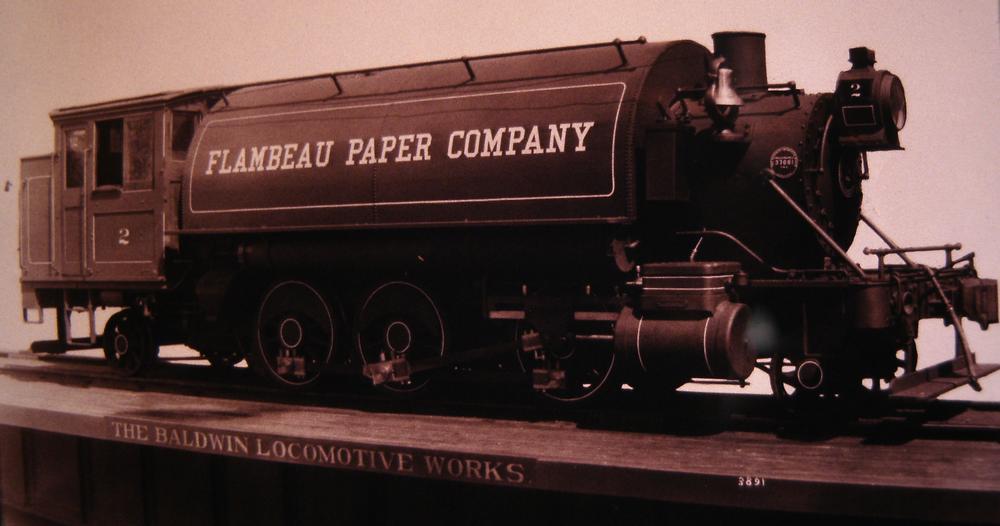
|
Here's one picture of Flambeau Paper Company No. 2 as it was getting old. It was originally bought as a locomotive that had to fit under a bridge, with limited height. Years later when the situation changed, and the cab roof was extended up to a more normal height. It was built to burn oil or coal, and I think it was coal because that was what the paper mill boilers burned.
|
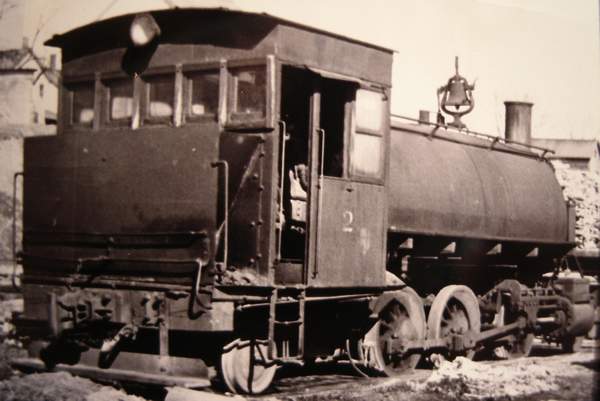
|
The third loco was their first diesel, a GE 45 tonner. It got the number 46; for 1946, the year it arrived. I have a poor picture of it sitting on a flatcar, being moved in by the steam loco No. 2. I don't know how they unloaded it from the flatcar. No. 46 ran until it had axle bearing trouble (again), and then went to the Lake Superior and Mississippi museum by Duluth, Minn. They have a lot of info about it. |
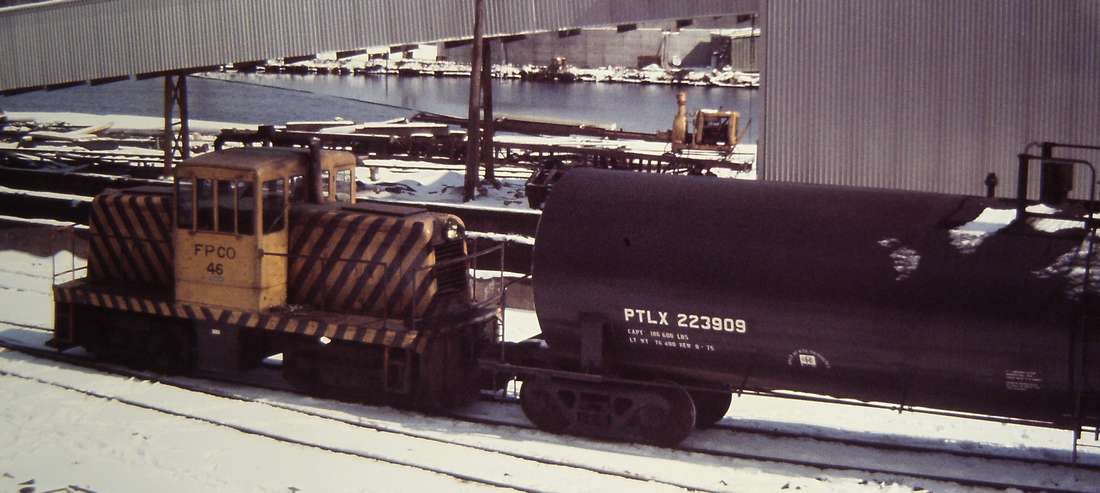
|
I don't have a really good picture of the used SW that arrived in 1984. But Rich P. has some. Here's one very good picture of his, better than any I have, on the RR picture archive site, Flambeau Paper SW 1 The buildings in the back ground of his picture were originally of the Heinz lumber company, and they were warehouse space for the paper mill for many years after.
|
.
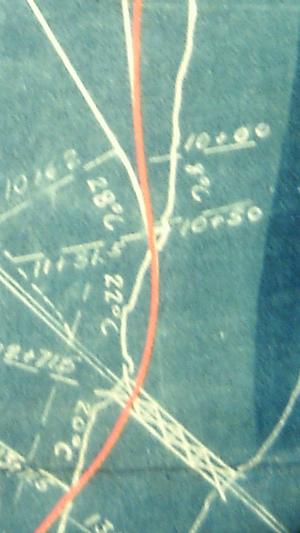 .
.
On the south side of the paper mill,
the paper company track used to go UNDER the Wisconsin Central / Soo Line.
It was confirmed when John B of the Price County Historical Society showed me an old postcard of that location.
The rails dropped down along the west river bank, almost to the water level.
The first original Wisconsin Central bridge over the river was a through-truss,
and had clearance underneath. But not much. Which is why the No. 2 was a very low-height locomotive, it didn't have anything above the water tank. No steam dome sticking up. The bell was mounted low on the side. The cab was very low; it should have been a foot higher if it was standard Baldwin design for the 2-6-2 logging locomotives.
That would jive with the map and stories that the paper mill tracks (red line) crossed under the WC main line, as shown on this 1916 blueprint.
Maybe there was a lot of fill on the west bank of the river?
There wasn't much headroom, and in high waters the mill rails at the underpass were known to be up to a foot under the water.
But the area has been built up enough over the years to bury the old R.O.W., and there's no traces of this portion.
I haven't been to Park Falls in years.
Rich P has recent pictures of the rail bridge over the Flambeau River.
Here is one on the rr pictures site,
Flambeau River Bridge
The modern riverbank is different than a hundred years ago.
The existing Soo Line / WC / CN bridge has been a steel girder since 1927,
and that would have been the end of the underpass.
.
|
In 2014, I learned some info about pulp grinders in general, from the paper science class at the University of Wisconsin, Stevens Point. I could still use more info. None of the grinding equipment existed at the main mill dam by the time I was there in the 1970's, but one fire pump was hooked up to the horizontal shaft that used to power one grinder at the main mill.
This picture came from a paper mill anniversary book,
showing an operator feeding 2-foot long bolts of wood. |
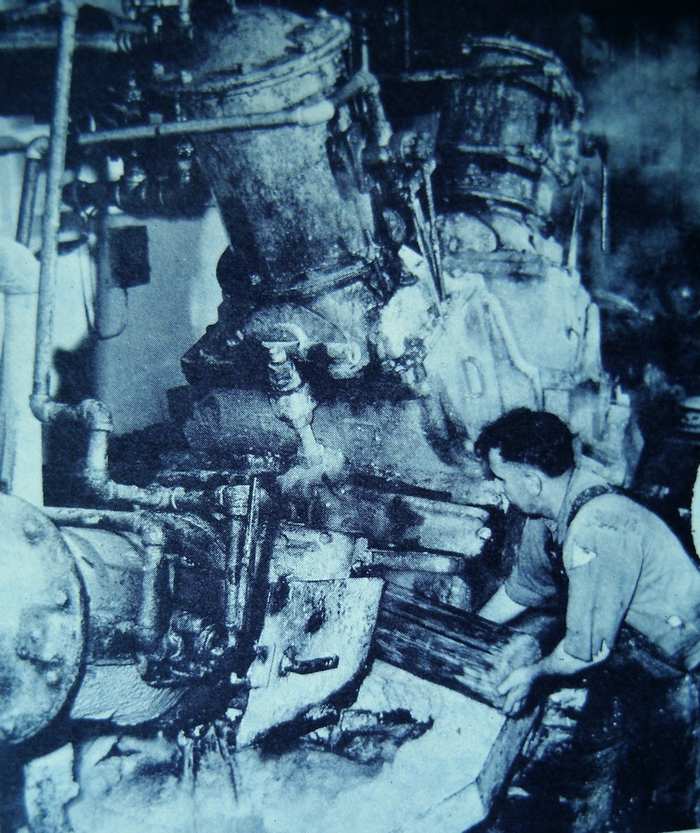
|
I might be able to get some pulp grinder info from the big paper mill in Wisconsin Rapids. I hear they still have a row of these groundwood pulp grinders, but they aren't used.
And I could use a picture of a Beloit wet-lap machine,
I suspect there's some working wet lap machines in the Fox River Valley yet, but probably more automated. |
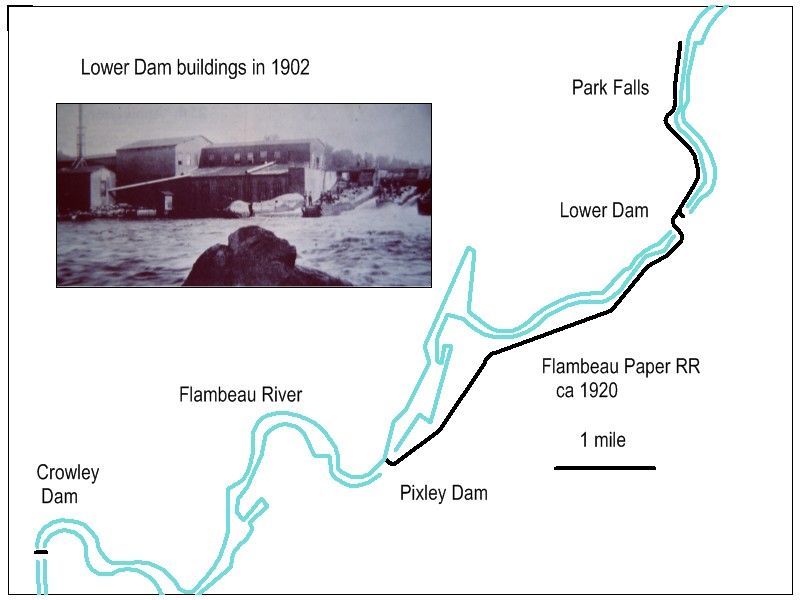
|
Here's a copy of one corner of a 1912 blueprint showing Lower Dam when it had pulp grinding. This dam can be seen from Highway 13 on the south side of Park Falls. A railroad spur (curved white lines) went halfway over the dam, so wood could be dropped by gravity from a box car to the saw and then lower to the grinder men working on lower levels. A short spur into the building was for flatcars, where the wet lap pulp was piled for the trip to the main mill. It sure doesn't look like that anymore. Long ago, it was converted to just electric power generation. |
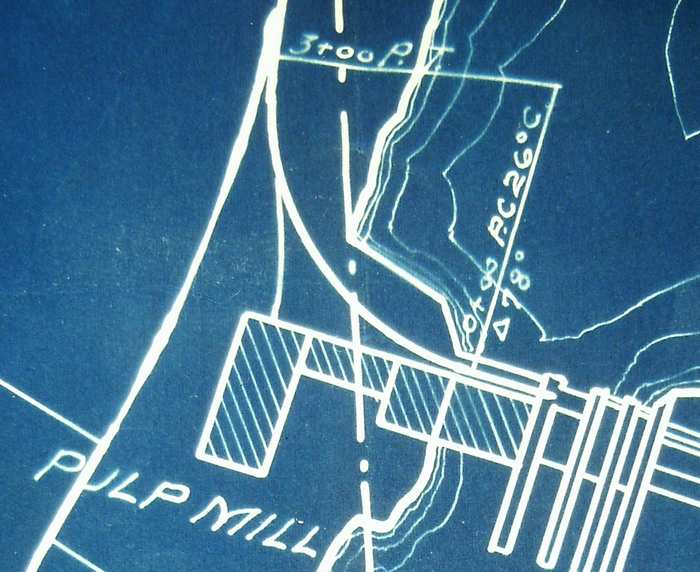
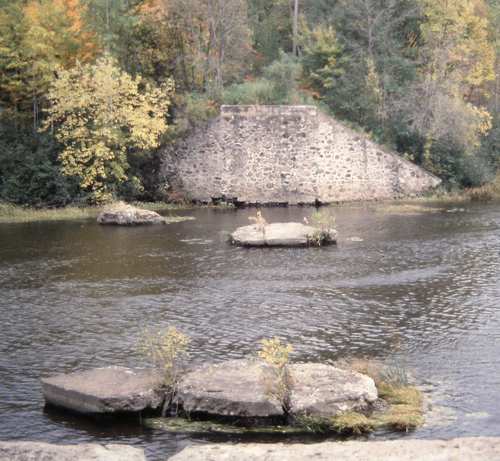 I have these slides of the foundations of the mill's rail bridge over the Flambeau River,
I have these slides of the foundations of the mill's rail bridge over the Flambeau River,
where the line went from the north bank near Lower Dam and crossed to the south side on its way to Pixley Dam.
They are just downstream / west of the Highway 13 bridge on the south side of Park Falls,
and for years I just thought they might have been footings of an old town road bridge.
And thanks to John B and the Guy Waldo picture collection, we have a 1910 picture. You can see it at
Flambeau Paper Company Railroad Bridge as shown on the Bridgehunter web site
and it is picture number 4 on that page; view it with a computer; Android and facebook might not be able to see pictures 2, 3, 4 of the series.
|
A Pixley Dam picture was in the dam files in the DNR (Dept of Natural Resources) offices in Madison, Wisconsin. A fellow design engineer saw it in the 1980's. I think it was in the DNR round tall building on the west side of Madison, and would be related to flood plain studies. I don't know if the picture is still in the DNR files. Is there anyone familiar with the DNR? The picture could be found and scanned for this history project? It showed Pixley Dam, with railcars on the track over the dam. (the picture might also be in the Guy Waldo collection, we haven't look yet as of 2019) |
|
I intended to make an article that could be published in the Soo Line Historical and Technical Society magazine, but that will be limited to information closely related to the Wisconsin Central and Soo Line railroads, and not be very involved with the story of the dams. I don't have many computer programs for writing articles. I don't have full-feature Acrobat. I have Corel Home Office, and that can also save simple files in pdf.
I do maps with engineering drawing programs; the latest one I have is TurboCad. . .
This history project will be in at least two parts.
The second part could be modern times, maybe 1970 to about 2006. .
So here's another history project that is quite unique. Anyone want to try a garden railroad with a flowing river and dams? How do they make those modeling articles in Model Railroader? If anyone has information and pictures to share, please contact me at the g-mail address on my main index page. |
.
Link back to my index page, Bruce's RailRoad Pictures
This page was originally wrote in February, 2012. Updated Jan, April, 2019.
My best index page is on the TrainWeb site, as of January 2011, and still is in 2019.